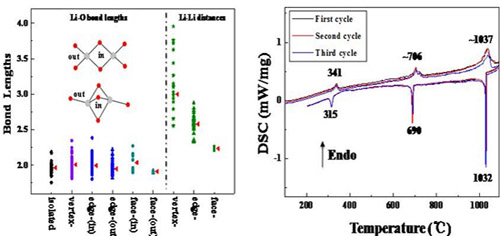Due to various assemble types of the trigonal BO3 or tetrahedral BO4 units, the structural multiformity of borates makes it attractive for researchers to explore new functional materials.
Borates containing planar BO3 units with p-orbitals have unsymmetrical electron density which may lead to large microscopic second-order susceptibility (b(2)) and optical anisotropy (Δn).
A research group led by Prof. PAN Shilie at Xinjiang Technical Institute of Physics & Chemistry (XTIPC) of Chinese Academy of Sciences synthesized a new lithium zinc borate Li6Zn3(BO3)4 and characterized it structurally for the first time. The study was published in Inorganic Chemistry Frontiers as a cover story.
Li6Zn3(BO3)4 crystallizes in the triclinic space group of P-1, and the BO3 triangles in Li6Zn3(BO3)4 are approximately parallel to each other, which generates a relatively large birefringence (0.065 at 1064nm).
Researchers reported that face-sharing LiO4 tetrahedra for the first time. The structure comparisons were carried out among all the available lithium-containing borates together with title compounds to analyze the particularity of face-sharing LiO4 tetrahedra.
They found that the shorter Li-Li distances in face-sharing LiO4 tetrahedra configuration will increase the repulsive force and decrease the stability of the structure, making the face-sharing LiO4 tetrahedra rarely found in the borates.
Besides, Li6Zn3(BO3)4 was found to have two reversible phase changes, which implies that Li6Zn3(BO3)4 is a potential candidate for phase change material.
This work was supported by the National Natural Science Foundation of China, National Basic Research Program of China, the National Key Research Project, etc.

Figure: Li-O configuration and the DSC curves of Li6Zn3(BO3)4(Image by XTIPC)
Contact:
Prof. PAN Shilie
E-mail:slpan@ms.xjb.ac.cn
Xinjiang Technical Institute of Physics & Chemistry, CAS
